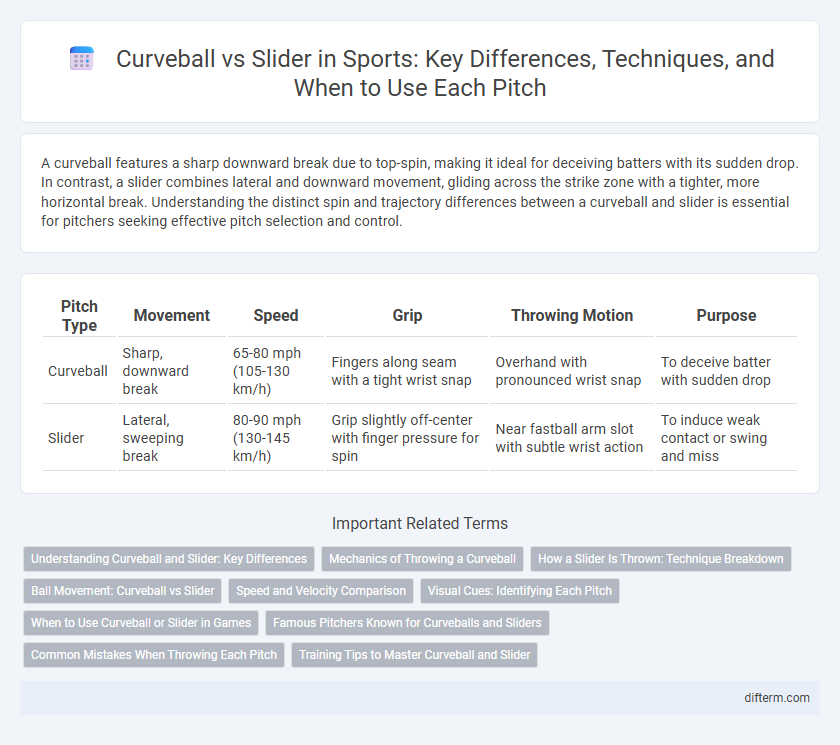A curveball features a sharp downward break due to top-spin, making it ideal for deceiving batters with its sudden drop. In contrast, a slider combines lateral and downward movement, gliding across the strike zone with a tighter, more horizontal break. Understanding the distinct spin and trajectory differences between a curveball and slider is essential for pitchers seeking effective pitch selection and control.
Table of Comparison
| Pitch Type | Movement | Speed | Grip | Throwing Motion | Purpose |
|---|---|---|---|---|---|
| Curveball | Sharp, downward break | 65-80 mph (105-130 km/h) | Fingers along seam with a tight wrist snap | Overhand with pronounced wrist snap | To deceive batter with sudden drop |
| Slider | Lateral, sweeping break | 80-90 mph (130-145 km/h) | Grip slightly off-center with finger pressure for spin | Near fastball arm slot with subtle wrist action | To induce weak contact or swing and miss |
Understanding Curveball and Slider: Key Differences
A curveball features a pronounced downward break due to topspin, making it slower and easier to detect early compared to a slider, which breaks laterally with a sharper, tighter movement caused by a combination of sidespin and backspin. Pitchers use the curveball to disrupt hitters' timing through its slower speed and dramatic drop, while the slider relies on late horizontal movement to deceive batters expecting a fastball. Understanding these differences enhances strategic pitching and hitting decisions in baseball.
Mechanics of Throwing a Curveball
The mechanics of throwing a curveball involve a tight grip with the middle and index fingers placed along the seam, combined with a downward wrist snap to generate the ball's characteristic top-spin. This spin causes the ball to break sharply downward as it approaches the plate, making it difficult for hitters to predict its trajectory. Understanding the precise arm angle and release point is crucial for pitchers to master control and maximize the curveball's deceptive movement compared to other breaking pitches like sliders.
How a Slider Is Thrown: Technique Breakdown
A slider is thrown with a grip that places the index and middle fingers along the outer edge of the baseball, creating lateral spin upon release. The pitcher snaps their wrist at the point of release to generate a sharp, late-breaking motion that differentiates the slider from a curveball's more arcing trajectory. This technique causes the slider to move horizontally and downward, making it an effective pitch for deceiving batters.
Ball Movement: Curveball vs Slider
The curveball exhibits a pronounced downward break due to its topspin, creating a sharp, arcing movement that deceives hitters with its vertical drop. In contrast, the slider generates a tighter, lateral break with a slight downward tilt, blending speed and horizontal movement to induce weak contact or swings and misses. Pitchers utilize the distinct spin and release angles of each to strategically disrupt a batter's timing and eye level.
Speed and Velocity Comparison
Curveballs typically range from 65 to 80 mph, exhibiting significant downward break due to top-spin, resulting in slower velocity compared to sliders. Sliders usually travel faster, between 80 to 90 mph, combining lateral movement with less vertical drop, making them harder to detect early. The velocity difference impacts batter reaction time, with sliders challenging timing and curveballs testing swing accuracy.
Visual Cues: Identifying Each Pitch
The curveball is characterized by a distinct downward break with a pronounced 12-6 motion, often recognized by the pitcher's wrist snapping downward at release, creating noticeable topspin. In contrast, the slider features a tighter, later break with a more horizontal and sweeping trajectory, identified by a slightly tilted wrist and less dramatic arm motion. Observing the spin and release point offers critical visual cues to accurately differentiate between these deceptive pitches.
When to Use Curveball or Slider in Games
Pitchers should use a curveball when aiming to disrupt a batter's timing with a slower, looping pitch that breaks sharply downward, especially effective against hitters expecting fastballs. A slider is preferable in situations demanding a faster, tighter break that moves laterally or down-and-away to induce swings and misses or weak contact. Choosing between a curveball and slider depends on the pitcher's control, game situation, batter's weaknesses, and desired movement to strategically outsmart hitters.
Famous Pitchers Known for Curveballs and Sliders
Famous pitchers known for their devastating curveballs include Sandy Koufax and Clayton Kershaw, both celebrated for their sharp, downward-breaking pitches that consistently deceive batters. In contrast, sliders, characterized by their late, horizontal movement, have been mastered by pitchers like Randy Johnson and Trevor Hoffman, whose precise control over the slider has led to numerous strikeouts. The distinct effectiveness of curveballs versus sliders often depends on the pitcher's mechanics and the batter's timing, making these pitches iconic tools in baseball pitching arsenals.
Common Mistakes When Throwing Each Pitch
Pitchers often make the error of over-rotating their wrist when throwing a curveball, resulting in a loss of control and reduced spin efficiency. When throwing a slider, failing to maintain a consistent arm speed can cause the pitch to flatten out, diminishing its sharp break. Proper grip and wrist alignment are critical to avoiding these common mistakes, ensuring deception and optimal pitch movement.
Training Tips to Master Curveball and Slider
To master the curveball and slider, prioritize consistent wrist snap and precise finger placement for effective spin generation and pitch control. Incorporate targeted drills like wall spins and resistance-band exercises to develop finger strength and enhance release mechanics, vital for both pitches. Regular video analysis helps refine arm angle and release point, ensuring the distinct movement of the curveball's sharp downward break and the slider's lateral glide.
curveball vs slider Infographic

 difterm.com
difterm.com